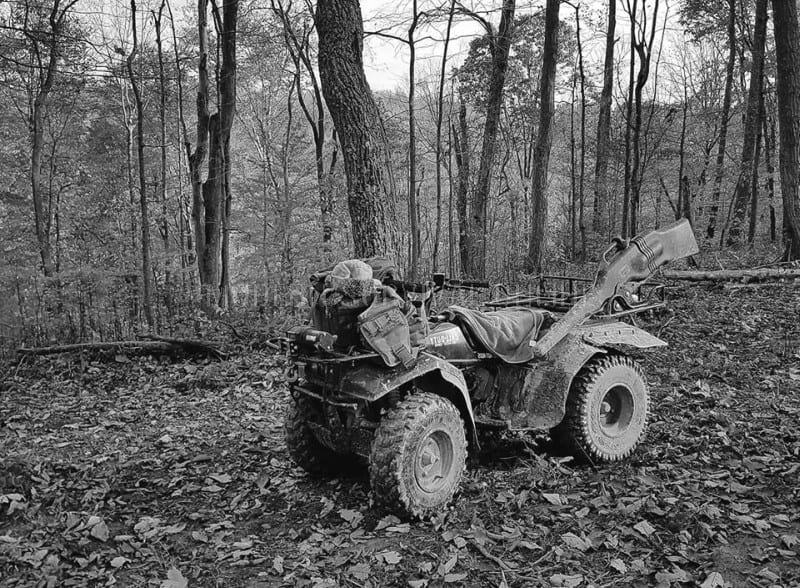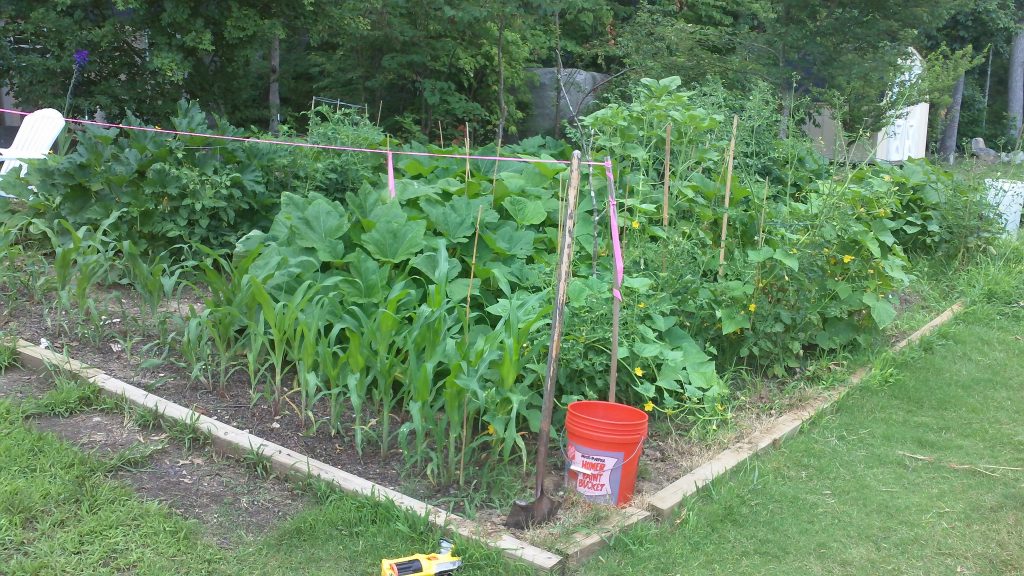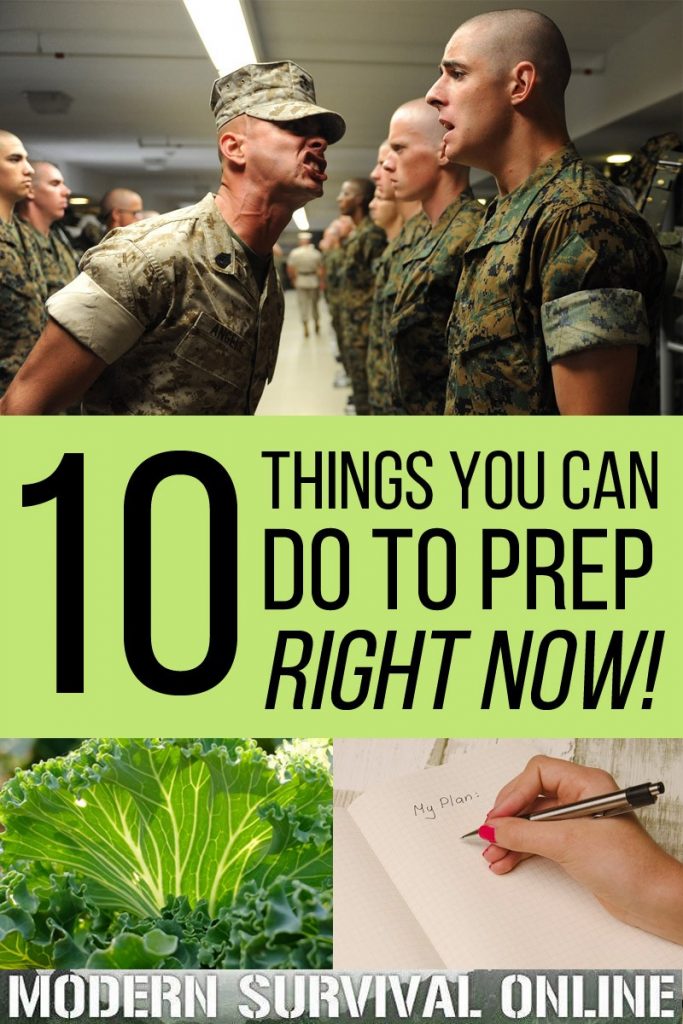Prepping can sometimes seem like a daunting and time-consuming task that takes a lot of money to do right, especially for beginners or non-rural preppers. But, that is simply not so.
Sure, there are many survival supplies that will have you digging deep into your pocket and activities that require multiple steps and preparation, but there are also many things you can simply get up from your laptop or smartphone and do right this very minute to prep.
Taking the very first step or even a renewed interest in prepping needs not be hampered by either your budget or time constraints. If you are inspired to get up and start prepping right now, you can accomplish some vital survival tasks – most without even spending a dime … no matter where you live.

1. Get Organized
This part of your prepping could be either low energy, or require a robust amount of manual labor. It all depends on how may preps you have stockpiled, and how developed your survival plan is.
All you need in order to do this crucial prep right now is a pen and paper. The first step in getting prepared is to set your survival goals, and develop a timeline to implement them. If you have already developed a survival plan, skip to number 2 on the list below.
Make a Survival Plan – Setting Prepping Goals
- Make a list of five to 10 things you need to do or achieve to become more self-reliant or skilled in order to survive a SHTF long-term disaster. For example: turn your home into a bugin location, find a bugout location – prepper retreat, stockpile basic essentials, list them each specifically, record the survival skills you possess and the ones you want to learn, etc.
- Make a prepper inventory of all the survival items you currently own, a list of all the food, water, and medicine you have on hand, and a list of items you want to purchase to make you more prepared in the following categories: food, water, medical, communications, bugout location, bugout bag, everyday carry – EDC, gardening, livestock husbandry, weapons, morale boosters, barter, tools, off grid cooking, and alternative power.
- Do a bit of math and determine how much of your budget you can devote to stockpiling preps or learning survival skills each week or month.
- Consider the amount of time your current work and family commitments require on a weekly on a monthly basis to determine how much time you can regularly devote to prepping.
- Create a timeline for accomplishing the purchases and goals that fit both your fiscal and free time schedule.
Once you have this necessary information infrastructure, you are well on your way to having an in-depth prepping plan and enhancing your chances of survival.

2. Physical Fitness and Endurance
Getting yourself in optimal physical shape should be at the cornerstone of your prepping plan. In our modern world, more and more people are living a sedentary lifestyle.
Increasing your muscle tone, strength, and endurance will help prepare you for the many physical hardships and manual labor that will be necessary to survive a long-term SHTF event.
If you are not used to working out on a regular basis, the physical challenges will be more intense during a disaster, and can likely lead to pulled muscles and tendons that will render you ineffective in a self-defense situation, for instance.
You may also have a hard time doing the multitude of rough daily chores that will be necessary in an off the grid world where you and only you are suddenly responsible for growing or raising all of your own groceries, keeping the family safe, and supplying alternative fuel sources to heath the home.
Free Ways To Get In Better Physical Shape You Can Do Right Now
- Go for a run.
- Go for a hike.
- Walk or run up and down stairs.
- Chop firewood.
- Find some 5 to 10 pounds food containers or similar items, and use them as weights to work out your arms.
- Put on music and dance for at least 15 minutes to simulate a cardiac workout.
- Do manual labor chores you have been putting off like cleaning out the garage.
- Take your dog for a walk.
- Do push ups to increase upper body strength.
- Do jumping jacks for at least five minutes,
- Do wall sits to increase leg and back strength.
- Find a YouTube fitness channel, and follow along.
- Throw a ball around with your kids.
- Set up an ax throwing range in your backyard (if legally allowed) and practice throwing the ax at a simple wood or hay bale target to increase strength in both arms.
These are just a few examples of free physical fitness training you could do right now without spending a dime to grow stronger in prepared for a SHTF scenario.
Once you get up and get moving you should find your energy levels increases and inspire yourself on to move lengthy or advanced physical training.
If you have any type of health condition or have not exercised in a long time, consulting your physician for tips and health risks is highly recommended.
3. Foraging
No matter what the season, there are likely always wild edibles growing on your land or somewhere around your home.
Going for a walk armed with a sack and the camera on your smartphone can help you not only acquire some wild edibles to taste, but also to bring home and learn more about the pros and cons of each, how to best identify the wild edibles, and any potential home remedy use they could provide.
Recommended Foraging Hike Wild Edibles
| Plantain | Daisies |
| Black Eyed Susans | Clover |
| Dandelion | Wild Strawberries |
| Wild Onions | Wood Sorrell |
| Blackberries | Black Raspberries |
| Cattail | Acorns |
| Walnuts | Purslane |
| Mullein | Bull Thistle |
| Coltsfoot | Curly Dock |
| Hickory Nuts | Milk Thistle |
| Coneflower | Blue Vervain |
| Chickweed | Fireweed |
| Alfalfa | Supplejack Vine |
| Morel Mushrooms | Echinacea |
| Pineapple Weed | Yarrow |
| Chamomile | Lavender |
| Field Pennycress | Queen Anne’s Lace – Wild Carrots |
| Stinging Nettles | Peppergrass |
| Lambs Quarters | Toothwort |
| Sowthistle |
Always consult with your doctor before embarking on any natural remedy regimen. Simply because something comes from nature does not mean it is either safe to eat or safe to eat for everyone.
Never eat any wild edible that you are not 100 percent sure both of its identification and that it has not been sprayed with any chemical pesticides.

4. Emergency Drills
Part of being prepared is practicing to be prepared. Everyone in your family, no matter how young, must learn how to react during an emergency.
Make a plan for each emergency scenario you think your family could be subjected to. Share the plan with your loved ones, and then practice how they should react when faced with the emergency both when they are at home or away from home.
Emergency drill training can take place both as part of a pre-planned or surprise event.
Types of emergency situations you should do drills for:
- Fire
- Flooding
- Hurricane or Tornado
- Sudden Power Outage
- SHTF when the family is separated – not at home
- Medical emergency at home, away from home, and during SHTF
- Home Invasion
- Lost child or elderly family member at home and away from home
- Martial Law Declaration
5. Water Collection
Start setting up a simple rainwater collection system with items you have on hand, or plan to implement one by purchasing items as a part of your survival budget.
You can also fill up empty plastic bottles and jugs with water.
6. Make a Cache
Find a piece of PVC pipe and connector ends, bucket with a firm fitting lid, or a trash can with a firm fitting lid, and create a survival cache to hide on your land – or somewhere along a frequently traveled route.
The items inside may need to be wrapped in plastic, or placed inside of a Ziploc bag to better protect them from the elements (if using a trash can as a survival cache).
Suggested Survival Cache Gear and Supplies
- Lifestraw, bottled water, or water purification tablets.
- Protein that has a long shelf life
- Weapon
- Ammunition
- First aid kit
- Map
- Compass
- Folding pocket knife
- Mylar emergency blanket
- Precious metals, cache, or other bartering material
- Flashlight
- Matches
- Poncho
- Paracord
- 2-way radio
- Solar cellphone charger
Unless you are sinking the survival cache in a pond or other body of water, the actually burying of the cache can also serve as part of your physical fitness prepper training.
7. Make a Faraday Cage
Making a Faraday cage to store you sensitive electronic devices in to protect them from an EMP attack or solar flare. Unless you feel so inclined, there is no need to drag out either power tools or manual tools to make a Faraday cage.
Use a metal trash can, metal box, metal chest, metal tool box, etc. as the base of your Faraday cage. Place cardboard along the bottom and sides of the Faraday cage to make sure none of the items inside are touching bare metal.
If the items are stored in their individual cardboard packaging, there is no need to do the cardboard lining, but it still wouldn’t hurt. Never store batteries inside of radios or other electronic devices.
Batteries of any type should be separated by cardboard from themselves, the device they will be used in, or the metal on the Faraday cage.
Before closing the lid on the Faraday cage, place a layer of cardboard on top of the items stored inside to add an extra layer of protection.
Suggested Items to store inside of a Faraday cage:
- 2-way Radio
- Electronic Tablet
- Solar Charger
- Jump Drive – Thumb Drive filled with important documents
- Laptop
- HAM Radio
- Electronic Medical Equipment
- Power Inverters
- Generators
If you keep a 2-way radio in your bugout bag, take the batteries out if and place both the radio and batteries in separate Ziploc baggies. Wrap multiple layers of aluminum foil around each plastic bag to create a makeshift portable Faraday cage.
There areheated debates about the level of protection aluminum foil provides, but it definitely does not hurt to give it a shot, and help protect your communication tools from natural or man-made EMPs.
8. Make a Radio Communications Code
You definitely do not want others who might listen in on radio transmissions between your family or mutual assistance group members.
Develop a simple code to serve as survival shorthand to allow communications to remain as covert as possible. Example: Blue means stay where you are, I am coming to get you.
Suggested Survival Communications Code Keywords And Phrases
- Stay where you are
- I’m coming to get you – help is on the way
- Rally point not safe
- Home is not safe, go to X
- Missing person found
- Possible attackers on our X perimeter side
- Unknown persons approaching
- Code name for each family member or survival group member.
- I found the survival cache
- I am ok
- I need help
9. Make an Off-Grid Communications Code
Radio batteries will not last forever, do not make a possibly fatal mistake of relying on them for communications for the duration of the long-term disaster.
Develop a simple no-tech communications code that can be used in place of radios in case batteries go dead, to prevent information from being detected by marauders who could read a regular written note.
Everyone in the family should be assigned a single color or symbol they can easily and quickly leave to let others know they are safe, or that they have been home or to the rally point, but had to leave and are going on to the bugout location or secondary rally point.
Whatever supplies used as tools in the off grid communications system should be lightweight and portable so they can be carried in bugout bags, purses, briefcases, and school bags. Never assume your loved ones will be either at home or all together when disaster strikes.
Example: a blue bandana or symbol could alert loved ones the house is not safe to enter so they travel to a designated rally point.
Suggested off grid communications code supplies
- Single colored bandanas
- Spray paint
- Paint pens
- Duct tape in different colors or patterns.
- Chalk – this will not work if the space where the design is left is not undercover in the rain or is found and disturbed before the message has been relayed.

10. Growing Your Own Groceries Planning
When the SHTF, expect grocery store shelves to go bare within just three hours and stay that way for weeks, months, or even years.
Things you can do to start or enhance your food cultivation efforts:
- Clean out your refrigerator, and start a compost pile outdoors.
- Find a bucket or other container with a firm-fitting lid, and use it as a kitchen compost container to regularly collect scraps that can be transported to the outdoor compost pile when it gets full.
- Dig up a little bit of dirt from all of your current or prospective ground growing plots and any existing compost pile to test the soil to determine pH balance and nutrient levels. It can take months to enrich subpar soil, so do not hesitate to launch into this prepping project any time of the year.
- Look for scrap materials or items that would otherwise be deemed trash that can be upcycled into growing containers. Plastic bottles, milk jugs, plastic barrels, old boots, cottage cheese containers, etc. are all great for starting seeds, growing herbs, and growing many types of vegetables.
Starting or enhancing your prepping can be just as simple as doing any of these superb 10 prepping right now projects.
Not only will you be invigorated to learn even more ways to build upon these initial efforts after getting rolling, you are bolstering your family’s chances of survival with each 5-pound coffee can lifted to get more muscle, and with every word written on a piece of paper to organize your preps or communications plan.
Get started prepping right now and don’t ever stop, there is always one more thing you can do or learn to increase the safety level of your family and to hone your survival skills.


Like what you read?
Then you're gonna love my free PDF, 20 common survival items, 20 uncommon survival uses for each. That's 400 total uses for these dirt-cheap little items!
We will not spam you.
I like the ATV pix. During the fall, a “Gun Boot” is quite frequently on mine. It rides on a home made bracket that mounts to the front of the front rack. Mine is built with a basic “‘H” pattern so the top is where the gun boot goes , the bottom bolts to the rack with “U” bolts , and there is a brace leg from the crosspiece extending rearward to make it stable. The Gun Boot is held in place with a rubber bungi strap. Car is taken to get the muzzle end of the. Gun Boot aimed toward the center of the ATV in front of the winch to keep it from snagging on brush. With the Gun Boot angled off to the right and close to my rt hand it doesn’t hang up and my movements to get the gun out are minimal. I’ve been using this set up since about ’85.